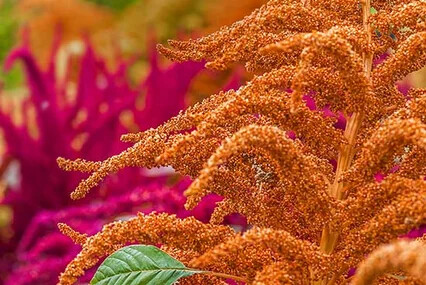Common name: Love-lies-bleeding, tassel flower, prince's feather, Joseph's coat, tampala, redroot, pigweed
Botanical name: Amaranthus species, hybrids, and cultivars
Family: Amaranthaceae
Hardiness: Zones 10–11; grown elsewhere as an annual
Conditions: Amaranthus prefer five hours a day of sun. They thrive in well-drained, average soil.
Bloom time: Summer to fall
Height: 1–8 feet tall; 1–3 feet wide. Some reach only 6 inches in height.
Best feature: As ornamentals, amaranths are planted for their dramatically colored leaves and striking pendulous tassels of flowers. The foliage and stems of some species are valued for leafy greens, cooked or raw. Seeds of several species are considered a major "pseudograin" crop and ground into flour.

Where to Grow as Ornamentals
Try amaranths grouped in various parts of the garden: perhaps as a backdrop for a border with tall verbena or purple fennel at their feet, in front of dark shrubs or the tropical foliage of Japanese fatsia or elephant ear. They also work as a hedge, around a cutting garden, or in a hanging basket or tall container.
Types of Amaranths to Grow
Joseph's coat is another favorite in this genus. Typically these are grown for their startlingly vivid upper foliage rather than for their flowers. They were favorites in Victorian parks and municipal gardens, where these exotic-looking plants were used as "dot" or accent plants in regimented beds and borders.
Everything You Need to Know About Joseph's Coat
In less formal locations, place crimson and yellow leaved 'Perfecta' or maroon-leaved 'Molten Fire' in front of evergreens that make the colorful foliage pop. Ornamental grasses are also good companions, particularly in fall when the amaranth foliage retains its color against the gradually browning grasses.
How to Grow Amaranthus
These plants are easy to grow in sunny spots (five hours or more daily) where soil drains well. Start seeds indoors as for tomatoes at 65–75 degrees F, two months or so before the last expected frost. This would be about mid-February for Zone 7 gardens; late February for Zone 6. Harden off the "toddler" seedlings to acclimate them before planting outdoors after the soil warms; they will not tolerate cold soil, and planting too early may cause stunted growth. In Northern regions, seeds can be direct sown after the last frost, but the crops will mature later. They usually take about three months from seed to bloom.
Average soil is fine for ornamentals, although the colorful foliage will not be as brilliant in overly rich soil. Avoid chemical fertilizers for edible crops.
When setting out into the garden, leave enough space between plants, 6 inches to 3 feet, according to their expected ultimate size.